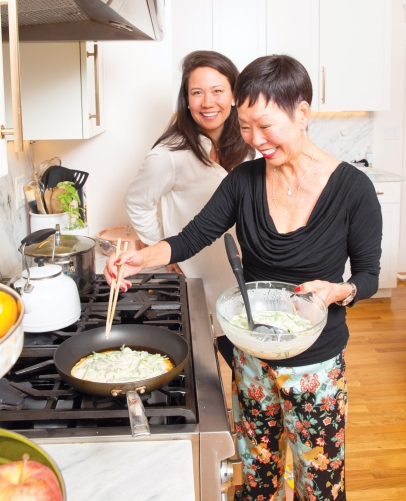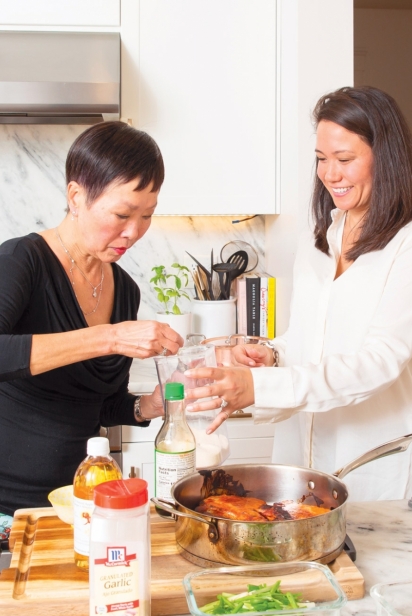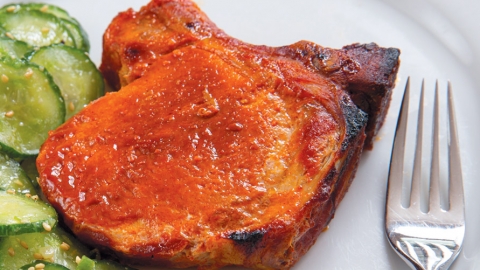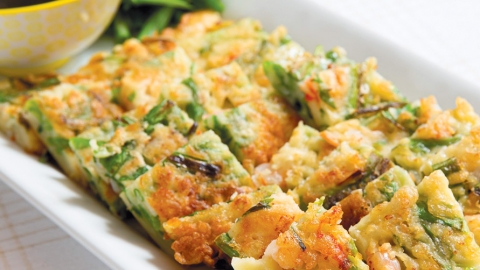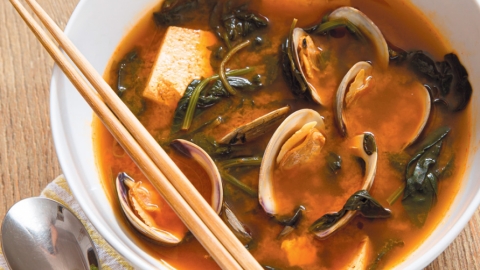Korean Home Cooking with Yehjong Son and Lahna Son-Cundy
A Rhode Island Family Honors Ancestral Culinary Traditions
New Year’s is a big deal in Lahna Son-Cundy’s household. Unlike American culture where the New Year’s Eve fête is celebrated on December 31, this extended Newport family celebrates Korean New Year on January 1. Their luncheon ritual includes dumplings—handmade with tofu, ginger, garlic, beef, shredded onion and sprouts, to be shared according to Korean custom—as well as duk mandu guk (rice cake soup with dumplings), with sake rice wine and laughter permeating the festivities.
Making and sharing these culinary traditions and delicious food passed down through generations allows mother and grandmother Yehjong Son and daughter Lahna Son-Cundy’s Korean heritage to be the heart of this special day. But the food continues year-round as a weekly dinner date, with recipes from Son’s mother that the two women have Americanized and simplified for their busy working lifestyles. Making Korean food and memories also helps Son-Cundy’s young children (with husband Joe Tamburo) experience and appreciate their international roots.
“A typical Korean dinner is five to 10 small side dishes, usually consisting of vegetables, then a stew in the center of the table that we share, and a fish or meat as well,” says Son- Cundy. “There are a ton of dishes and ingredients, and we don’t have time for that on a daily basis, but we do try to mimic that same sense of family gathering.”
Son’s parents immigrated to New York City when Son was 8 years old. Her father, Duk Sung Son, the grandmaster of the World Tae Kwon Do Association, instructed the Korean military, brought the practice to America and taught Son, who is now president of the World Tae Kwon Do Association, and Son-Cundy, who achieved a second-degree black belt.
Son’s mother was an extraordinary cook, and Son affectionately recalls her homemade soy sauce, miso and spicy gochujang—”none of which I know how to make. By the time I came [to America], it was accessible to buy, so there was no need to make them,” Son says. “But when I came to Rhode Island and wanted Korean food, I didn’t know what to do, so I had to call her to get measurements. But because I knew what the dishes should taste like and look like, it was easy to tweak to get it exactly the way she made it.”
Son continues to prepare fresh noodles, dumplings, kimchi and a variety of stews and soups from memory, with no formal recipes or measured ingredients, which Son- Cundy jokes is the way she learned, too. Adapting dishes to suit their schedules was critical when Son and later Son-Cundy were running their Tropical Gangsters and Tropical Gangstilettos boutiques on Newport’s Thames Street for 36 years.
Spicy Korean pork became indispensable. Traditionally, a tenderloin is sliced thinly and grilled on an open flame, then served in smaller portions. For their quicker contemporary version, they marinate a whole bone-in chop, then bake it in the oven and serve it individually for eaters to cut themselves.
“The dishes we make now are weeknight staples, like Korean pork chops, because they can be done without great effort or time, which is divergent from traditional Korean cooking,” Son-Cundy says.
“The components are there, but the method of cooking is different,” Son adds, “so I can call it ‘Korean’ without feeling bad that I was bastardizing the whole thing.”
Making it palatable for western palates may have inspired the preparation, but Son remains particular about the presentation. When making pajeon, she aligns each scallion sliver to infuse each bite of pancake with its flavor; ensures the mix isn’t too thick in the pan so the pajeon cooks evenly to a crisp golden brown; and insists on flipping each one according to her specific timing. Her method for cooking rice also is enchanting: She rinses the rice until the water runs clear, then fills enough water in the pot so that when she inserts her finger, it touches her first knuckle.
Some chefs are methodical, some are whimsical, and these women may very well be both. The passion they imbue in these meals is evident when they dance through the kitchen, adding a little of “this” magical ingredient and a little of “that,” Son-Cundy accepting her mother’s delicate instruction because she’s serious about the outcome.
Son-Cundy credits her childhood, eating dinner with her parents every night, for influencing her own approach to cooking and parenting, because it showed love through food. Even after a full workday, Son would sometimes prepare multiple meals if her daughter and husband didn’t like or want what was available. If they were sick or when Son took time to care for her ailing mother, everyone relied on Son’s “Mom in a can” meals, where pre-marinated pork chops, chicken or stews could be heated and served in less than 45 minutes.
These dishes continue to provide comfort and connection for this family, as they have done for centuries of Koreans, especially Son-Cundy’s daughter who refuses traditional western kids’ meals like hamburgers and demands Korean spicy miso soup or stewed tofu instead.
“Overall, the food is very healthy; nothing is deep fried,” says Son. “It’s not heavy on huge pieces of meat so we’re not overeating. Pickled vegetables are great for gut and brain health. And the rice and soup fill you up, while the other items punctuate the savory tastes. It’s the flavors of home.”
Find authentic Korean dishes or ingredients at these Rhody establishments:
Asiana Food Market, East Providence; on Facebook @AsianaFoodRI
Bapsang, North Kingstown; BapsangRI.com
Chi Kitchen, authentic kimchi made in Rhode Island, found in grocery stores around New England; ChiKitchen.com
Mokban Korean Bistro, Providence; Mokban.com
Sea Shai restaurant, Middletown; SeaShai.com
Sun & Moon Korean Restaurant, East Providence; SunAndMoonKorean.com
Sura Korean BBQ, Johnston; SuraBBQKorean.com


